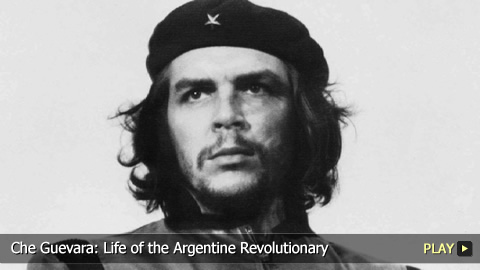Che Guevara: Life of the Argentine Revolutionary

- He was Che. Welcome to WatchMojo.com, and today we're learning more about the life of Che Guevara.
- Growing Up
- Studying Medicine
- Politics and Revolutionary Ideas
- Che
- Fidel Castro
- Cuban Revolution
- La Cabana Fortress
- Land Reform and Economic Initiatives in Cuba
- Bay of Pigs and Cuban Missile Crisis
- Books
- Congo and Bolivia
- Death
- Controversial But Influential Figure
Growing Up
Ernesto Guevara was born June 14th, 1928 in Rosario, Argentina. As a child, he was exposed to politics by his leftist parents and the diverse books in his family library.
Studying Medicine
Despite his athletic abilities, Guevara studied medicine at university in the late 1940s. As a student, he embarked on several trips and had his eyes opened to the poverty-stricken conditions of his fellow Latin Americans.
Politics and Revolutionary Ideas
Guevara soon decided that the key to a better future for Latin America was a continent without borders or boundaries, and in his eyes this could only be achieved through armed revolution. As a result, after getting his degree in the early 1950s, Guevara abandoned medicine and turned to politics.
Che
During this time, Guevara earned the nickname “Che” due to his frequent use of the saying, which roughly translates to “bro.”
Fidel Castro
Che soon relocated to Mexico City, where he met future Cuban leader Fidel Castro and his brother Raúl, who were members of the 26th of July Movement. That revolutionary organization was assembling a rebel army to bring down Cuban President and dictator, Fulgencio Batista. After joining their cause, Guevara became proficient in guerrilla warfare and built a reputation for being a merciless military advisor who never thought twice about punishing traitors.
Cuban Revolution
Following a botched attempt at overtaking Cuba in 1956, the armed radicals succeeded two years later: Guevara and his troops ultimately won the Battle of Santa Clara and set the stage for Batista’s resignation.
La Cabana Fortress
In 1959, Castro became Cuba’s Prime Minister and put Guevara in charge of the fate of the war criminals at La Cabaña Fortress. As commander, Guevara evaluated the appeals of traitors and other prisoners, and dispensed his version of “revolutionary justice” by sometimes having detainees executed by firing squad.
Land Reform and Economic Initiatives in Cuba
Once he became heavily involved in the development of Cuba’s agricultural reform policies, Guevara was appointed Minister of Industries of the National Institute of Agrarian Reform and presided over land redistribution. After also becoming Finance Minister and President of the National Bank, he implemented various economic initiatives that stressed moral rewards over material ones, but these proved unsuccessful.
Bay of Pigs and Cuban Missile Crisis
During this period, Guevara’s training of the Cuban army helped block the American attempt to overthrow Castro in the Bay of Pigs Invasion. Guevara also aided in the development of strong ties between Cuba and the USSR, and contributed to the plans to place Soviet nuclear missiles in Cuba ahead of 1962’s Cuban Missile Crisis.
Books
Throughout the 1960s, Guevara shared his political views by visiting several countries and publishing two books, one of which discussed his Marxist leanings and the Cuban revolution, while the other dealt with guerrilla fighting. But, his growing condemnation of the Soviet Union and his subsequent alignment with Communist China put him at odds with Castro.
Congo and Bolivia
By 1965, Guevara decided other countries could benefit from his vision. He and several Cuban guerrilla soldiers poured their efforts into resolving the Congo Crisis. The next year, he went to Bolivia to establish the foundations of a revolution. However, both he and his guerrilla army encountered numerous obstacles, including unaccommodating local rebels.
Death
The failure of Guevara’s National Liberation Army ultimately came at the hands of a special team of Bolivian combatants trained by CIA-hired Cuban officer Felix Rodriguez. After attacking his army, the group captured Guevara and gave him to the Bolivian military for questioning. On October 9th, 1967, they executed him. Guevara’s remains were presumed lost for thirty years, until they were discovered in a mass grave and buried with military honors.
Controversial But Influential Figure
While some see Che Guevara as a heroic guerrilla fighter, others believe he was a heartless man who never hesitated to incite conflict. Either way, his likeness is an enduring pop culture image that solidifies his status as an unrivalled figure of rebellion and revolution.
